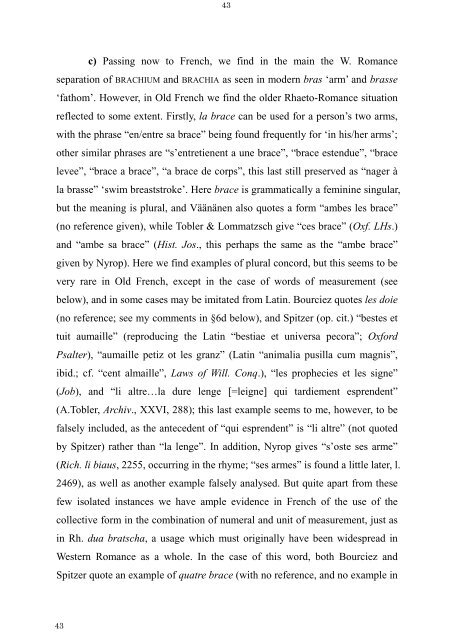The Latin Neuter Plurals in Romance - Page ON
The Latin Neuter Plurals in Romance - Page ON
The Latin Neuter Plurals in Romance - Page ON
Create successful ePaper yourself
Turn your PDF publications into a flip-book with our unique Google optimized e-Paper software.
43<br />
43<br />
c) Pass<strong>in</strong>g now to French, we f<strong>in</strong>d <strong>in</strong> the ma<strong>in</strong> the W. <strong>Romance</strong><br />
separation of BRACHIUM and BRACHIA as seen <strong>in</strong> modern bras ‘arm’ and brasse<br />
‘fathom’. However, <strong>in</strong> Old French we f<strong>in</strong>d the older Rhaeto-<strong>Romance</strong> situation<br />
reflected to some extent. Firstly, la brace can be used for a person’s two arms,<br />
with the phrase “en/entre sa brace” be<strong>in</strong>g found frequently for ‘<strong>in</strong> his/her arms’;<br />
other similar phrases are “s’entretienent a une brace”, “brace estendue”, “brace<br />
levee”, “brace a brace”, “a brace de corps”, this last still preserved as “nager à<br />
la brasse” ‘swim breaststroke’. Here brace is grammatically a fem<strong>in</strong><strong>in</strong>e s<strong>in</strong>gular,<br />
but the mean<strong>in</strong>g is plural, and Väänänen also quotes a form “ambes les brace”<br />
(no reference given), while Tobler & Lommatzsch give “ces brace” (Oxf. LHs.)<br />
and “ambe sa brace” (Hist. Jos., this perhaps the same as the “ambe brace”<br />
given by Nyrop). Here we f<strong>in</strong>d examples of plural concord, but this seems to be<br />
very rare <strong>in</strong> Old French, except <strong>in</strong> the case of words of measurement (see<br />
below), and <strong>in</strong> some cases may be imitated from <strong>Lat<strong>in</strong></strong>. Bourciez quotes les doie<br />
(no reference; see my comments <strong>in</strong> §6d below), and Spitzer (op. cit.) “bestes et<br />
tuit aumaille” (reproduc<strong>in</strong>g the <strong>Lat<strong>in</strong></strong> “bestiae et universa pecora”; Oxford<br />
Psalter), “aumaille petiz ot les granz” (<strong>Lat<strong>in</strong></strong> “animalia pusilla cum magnis”,<br />
ibid.; cf. “cent almaille”, Laws of Will. Conq.), “les prophecies et les signe”<br />
(Job), and “li altre…la dure lenge [=leigne] qui tardiement esprendent”<br />
(A.Tobler, Archiv., XXVI, 288); this last example seems to me, however, to be<br />
falsely <strong>in</strong>cluded, as the antecedent of “qui esprendent” is “li altre” (not quoted<br />
by Spitzer) rather than “la lenge”. In addition, Nyrop gives “s’oste ses arme”<br />
(Rich. li biaus, 2255, occurr<strong>in</strong>g <strong>in</strong> the rhyme; “ses armes” is found a little later, l.<br />
2469), as well as another example falsely analysed. But quite apart from these<br />
few isolated <strong>in</strong>stances we have ample evidence <strong>in</strong> French of the use of the<br />
collective form <strong>in</strong> the comb<strong>in</strong>ation of numeral and unit of measurement, just as<br />
<strong>in</strong> Rh. dua bratscha, a usage which must orig<strong>in</strong>ally have been widespread <strong>in</strong><br />
Western <strong>Romance</strong> as a whole. In the case of this word, both Bourciez and<br />
Spitzer quote an example of quatre brace (with no reference, and no example <strong>in</strong>









